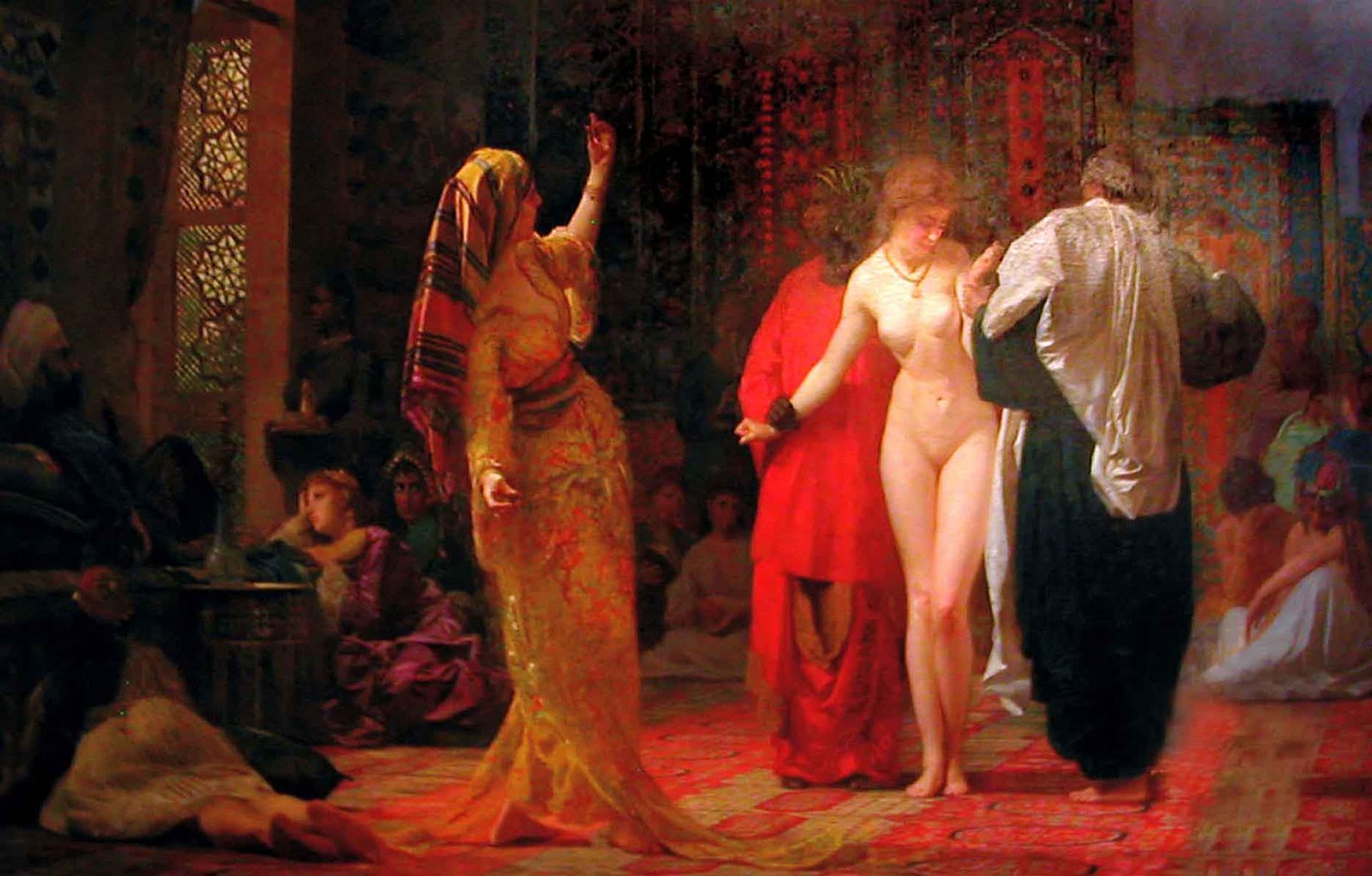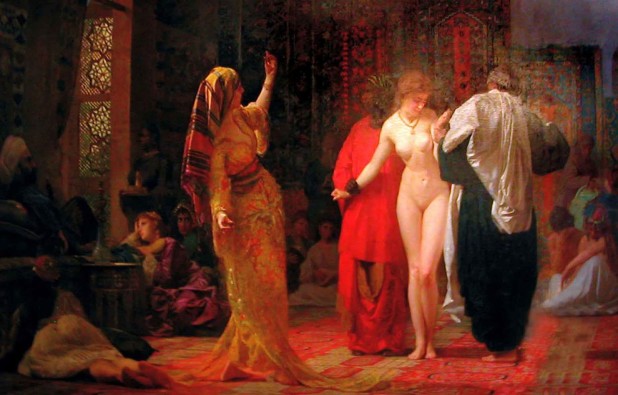Andrew Anglin
Daily Stormer
April 18, 2016
Diversity Macht Frei gives us an excerpt from “Blond, Tall, with Honey-Colored Eyes: Jewish Ownership of Slaves in the Ottoman Empire” by Yaron Ben-Naeh:
Hundreds of Hebrew written sources, dozens of official decrees, judicial records (sijillat), and reports of European travelers indicate that slaveholding – particularly of females of Slavic origin – in Jewish households in the urban centers of the Ottoman Empire was widespread from the sixteenth to the nineteenth centuries. This halachically and legally problematic habit was an unparalleled phenomenon in any other Jewish community in the early modem period. The presence of slaves in Jewish households effected family life in many ways. I dealt with two of them: The first is cohabitation of Jewish men with female slaves, usually non-Jewish, who in effect served as their concubines and bore them legitimate children; the second is marriage with manumitted slaves who converted to Judaism and became an integral part of the community. These phenomena attest once again to the great extent to which Jewish society and its norms and codes were influenced by Muslim urban society, and the gap between rabbinic rhetoric ideals and the dynamic daily existence of Jews from all social strata.
Slavery and slaveholding has been among the most outstanding aspects of life in the various and varying Muslim societies over the centuries. As is reported by hundreds of Hebrew sources, dozens of official ordinances, documents produced by the Shari’a courts, and the reports of European travelers, slaveholding was also common among Jews in Muslim lands. The ownership of women, in particular, was widespread in Jewish households in the Ottoman Empire on the threshold of the modern era. It was certainly far more common than in Jewish communities in North Africa or Europe.
…
The documents concern female slaves almost exclusively; I found only one case concerning a male. Slavery thus seems to have been limited to those who would provide household services of the kind exclusively performed by women, including sexual ones. This helps explain why nearly all the slaves were white females, principally of Slavic origin captured during Ottoman campaigns, or by their Tatar collaborators in Eastern Europe, with only a few of other provenance – Circassian, Caucasian, Hungarian, and Austrian. Black slaves are not mentioned. Physical descriptions of female slaves remark about fair hair and light-colored eyes, although, possibly, this simply reflects the general characteristics of the captured and enslaved women; male preference, however, should not be ruled out. Women, too, bought slaves, but most likely the traits women sought out were domestic skills, physical strength, and an obedient nature. Beauty, for them, was no doubt for the most part irrelevant, although it may have been they considered slave owning an act of conspicuous consumption, the slave being a “beautiful object” to be shown off. No wonder, the documents speak of female slaves who were deformed and scarred.
Many, if not the large majority, of the women brought from Balkan and Eastern European regions were originally Christians, and they are identified accordingly as nasraniyye, isaviyye milletinden. When religion is not specified, we may assume that at least some of the women had converted to Judaism and were given Jewish names. Others retained their Slavic or Balkan birth-names. Muslim slaves are not mentioned, although we shall see that Jews did hold Muslim slaves. The owners were individuals, both men and women. Sometimes the ownership was shared by several family members (whether as a result of purchase or inheritance) or even in partnership with neighbors.
In most cases, the sources are silent about the duties of slaves or the substance of relations – particularly of the women – with their male or female masters. What little information we have comes from Hebrew sources, and it clearly points to female slaves performing household chores alongside hired servants. Many of them also served as concubines, in what the documents indicate was, on the whole, relative harmony with the lady of the house. Writs of manumission registered in the courts often note, too, that the owners are freeing a female slave who had served them loyally and obediently
…
The presence of non-Jewish slaves in Jewish households posed halachic problems, especially when dealing with food. Was the food slaves touched, even accidentally, and especially wine still kosher? And what about the work slaves performed on the Sabbath?43 The legitimization of illegal offspring was especially thorny. The obvious solution, to convert the slave, was not free of contradictions: The slave could touch and prepare all food, but he or she could not be made to work on the Sabbath. Apparently, most Jews preferred not to convert their slaves even though at times, this was against the explicit wishes of the latter. It was deemed preferable to take advantage of having non-Jewish members in the household. Many rabbis, need it be said, were critical of this practice.
Sexual relations with a female slave was a particularly acute problem. Distinct from Islam, which gives slave owners the right to sexual intercourse with female slaves, whose offspring also belong to him and are considered legitimate heirs, Judaism tends to prohibit this practice, at least “before the fact”. Maimonides had already ruled that a man who engages in sexual relations with his slave must free her and marry her as a convert to Judaism – or send her away from his household. Much of the reason for the prohibition was the prevention of halachic infractions, first, of the rule against cohabitating with a non Jewish woman, and, second, the laws of menstrual separation. To be sure, these issues did not arise first in Islamic lands. What I believe was new there was the increased concern among halachic authorities. Cohabitation with slaves had not only become somewhat common, but the general Jewish population considered it acceptable.
The sources offer two justifications for ignoring earlier prohibitions: the female slave was bought with “my” money, and I am permitted to do whatever I want with her; the price of payment was also her “marriage price”. Muslims were saying similar things, and it clear that norms customary in Muslim urban society were influencing Jews. … Jewish women in Cairo were known to have had illicit relationships with male slaves, no doubt one reason why Rabbi Joseph Karo denounced keeping male slaves – even the very young in the household. He feared their presence would stimulate adulterous conduct. … For males, sexual liaisons with slaves provided a combination of a convenient, generally socially (if not halachically) acceptable, even respectable, ongoing relationship with a woman who was seemingly inferior and a stranger, but nevertheless attractive from many aspects – while he was also able to circumvent the practical injunctions against taking a second wife.
The husband – actually, every male – could take up with any woman he chose according to his personal inclinations and taste (beauty probably played a greater role than we may assume), without the need either to receive dispensation from his vow not to marry another or to comply with the venerable, yet still problematic, Jewish ban against bigamy. Possibly, under the circumstances we have described, he could even do this without incurring resistance from family members, even his wife. It may also have been a comfort to husbands, as well as wives, that this woman did not threaten the legal wife’s status. For the man, this meant that he was also free from the legal and halachic restrictions that applied to a wife. The slave, furthermore, was always available and uncompromisingly obedient – she had to be, in fact, since sexual relations were considered a slave’s domestic duty. Resisting or lodging complaints would have been fruitless, as well as folly. Nor was her upkeep great, which was essentially limited to her daily needs. In addition, lacking a family that might intervene and defend her, was another advantage. She could easily be removed from the household without a writ of divorce and without the considerable financial compensation one would owe a true wife.
…
There are also no references to racial purity, an issue that much concerned the western Sephardic diaspora, reflecting ideas then current in the Iberian peninsula. The heterogenous populations found in Muslim cities, with their multi-cultural*nature, no doubt account in part for this lack of discrimination. Contributing, too, was that in the Ottoman world slavery was not synonymous with membership in a specific religious, national, or (what today we would call) ethnic group. Perhaps most importantly, Jewish identity itself in Ottoman territories at the beginning of the modern period was not conditional on origin, heritage, or language, but on open identification and the practice of traditional customs.
Any filthy thing you can think of: if you look hard enough, you’ll find a Jew at the center of it.
Also note that the Jews did very well in the Ottoman Empire – no wonder they’re trying to establish a new one.


